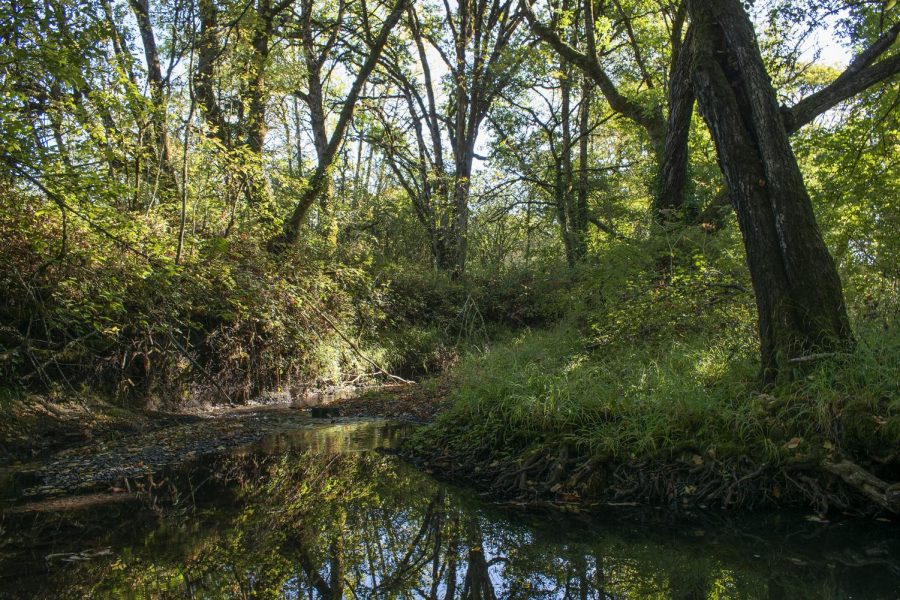On Oak Creek, ‘what we do upstream affects downstream’
October 15, 2021
Correction: This story has been updated to say that baptisms in Oak Creek were performed by Euro-American settlers. A previous version incorrectly stated that these baptisms were done by the Kalapuya tribe.
Oak Creek, a small river that travels across the Oregon State University campus, is more intertwined with the environment than its appearance suggests, but it’s being changed by human pollution.
Alan Shay, a level one senior instructor of horticulture at OSU, explained Oak Creek’s scope: all water bodies lead to a larger water body. Oak Creek’s headwaters—the source of a stream or river—join the Marys River south of Corvallis, which then flows into the Willamette River to the east. The Willamette carves a path north towards the Columbia River, which finally empties into the Pacific Ocean.
Innumerable varieties of organisms congregate near the water as it travels through this complex system, like thirsty animals to a desert oasis.
In the same way, Shay explained that historically, humans gravitate to water because watersheds supply a region.
With the advancement of human technology, however, David Eckert, the volunteer leader of the Water Action Team of the Corvallis Sustainability Coalition, said there is a changing relationship between people and water.
Eckert called the current interactions concerning humans and water a transitionary culture, meaning many people no longer experience or interact with their environment.
Eckert described the past integration of Oak Creek into economies and cultures as a gathering place, having been used for Euro-American settler baptisms and, later, for the operation of mills.
Now, said Eckert, we use the environment for recreation because it doesn’t have the same direct impact on our lives.
“So we’ve lost that cultural connection, we’ve lost that connection of subsistence through the creeks and we’ve lost the appreciation [of Oak Creek],” Eckert said.
Shay added that, nowadays, humans don’t feel they need the same relationship with the environment as they did hundreds of years ago. To get water, turn on the faucet. To get food, buy it at the grocery store.
John Lambrinos, associate professor in the Department of Horticulture at OSU, highlighted urban development around Oak Creek as a major cause of warming stream temperatures. Reduced tree and foliage cover around the stream exposes the water to excessive sunlight.
According to Shay, invasive growth such as blackberries and English ivy compete with native foliage and trees, further challenging their ability to survive and provide shade.
Lambrinos also explained that high amounts of harmful runoff containing oil, trash, animal excrement and fertilizer, among other substances, enter the water and raise its temperature. Higher water temperature decreases the stream’s capacity to dissolve oxygen, preventing fish and other organisms from surviving.
The impact of human pollution, however, is not limited to the stream’s immediate surroundings.
The Oak Creek watershed constitutes a significant area of west Corvallis and, according to Eckert, includes a drainage range of between seven and 11 miles. He explained that stormwater funnels into the stream.
“[Oak Creek] is almost like a landfill—only it’s a waterfill,” Eckert said.
In addition to this, Eckert said man-made dams restrict fish from reaching migratory headwaters to reproduce, they restrict the thermal load of water moving downstream—which increases water temperature— and they block sediment and organic materials from passing downstream. He explained that sediment is a necessity for aquatic organisms living at the bed, or bottom, of the stream and organic materials provide nutrients to those organisms.
On the other hand, according to Eckert, beaver dams allow fish, sediment and organic materials to pass downstream, and they help diversify the organisms in the ecosystem. He added that the obstruction of organic materials and sediment in Oak Creek eventually deprives organisms in the ocean of food and habitat as well.
Lambrinos explained the importance of focusing on local change which, downstream, will culminate into a larger change.
“A stream is a great, both a metaphor [and] an actual, real example of this,” said Lambrinos. “All these individual actions along the stream flow down, and your actions are affecting the person downstream, and their actions are affecting the person downstream.”
Several organizations and groups in Corvallis continue to do research and lead conservation on Oak Creek, among other waterways.
Shay said he has led volunteers out to Oak Creek to restore native plants and establish vegetative buffers. The new foliage provides the stream with shade and natural protection for human development. The roots also help stabilize the soil and prevent erosion on the bank.
Eckert has led the Water Action Team of the Corvallis Sustainability Coalition in releasing informative content about the ecosystems of Oak Creek and other streams in Corvallis as well as tackling water sustainability projects in the area.
Eckert’s Water Action Team is currently working on an extensive project to restore Dunawi Creek at the Bald Hill Natural Area.
OSU itself has done significant research and led conservation efforts in Oak Creek, including an ongoing project to safely remove the last remaining man-made dam on Oak Creek.
Eckert said there are some encouraging as well as discouraging developments on Oak Creek. Hopeful aspects include improving fish passages, restoration and beaver research. He explained that the lower regions of the creek running through the OSU campus next to Reser Stadium and residential areas continue to experience the greatest strain from urban development and channelization.
“It’s gonna take a change in our paradigm of thinking in the lower part [of the stream] before the most important work can be done,” said Eckert. “And, I think that’s decades off, if not years off.”
Shay explained the consequences of human interference in Oak Creek as part of a closed-loop.
“We’re drinking the same water that Native Americans drank centuries ago,” Shay explained. “Water is not created, nor destroyed. It’s recyclable.”
Eventually, Oak Creek’s polluted water will reach the ocean, evaporate, and come back as rain.










































































































